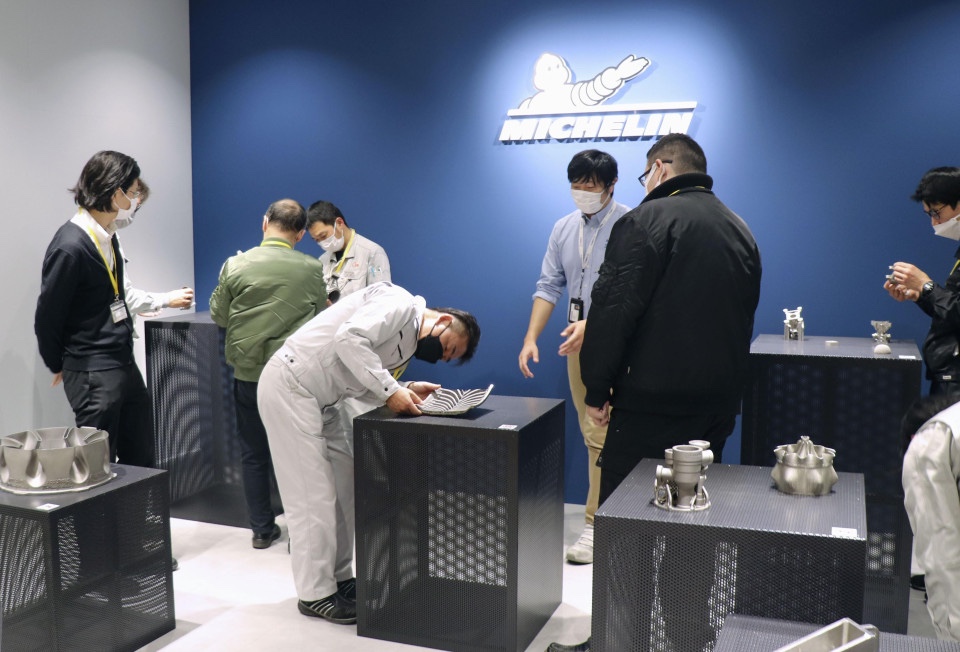In 2016, French tire giant Michelin and Paris-based industrial engineering corporation Fives Group partnered to establish AddUp Solutions, an original equipment manufacturer (OEM) of metal powder bed fusion (PBF) 3D printers. In addition to the 2018 acquisitions of BeAM, a French OEM specializing in metal directed energy deposition (DED) platforms, and a majority stake in Poly-Shape, a metal 3D printing design firm, AddUp has been busy refining all aspects of its platform.
This is evident from its dramatic ramp-up of publicly announced activity over the past few years. For instance, in the summer of 2022, 3DPrint.com’s Sarah Saunders visited the open house celebrating the grand opening of the AddUp Solution Center, a 20,000 square foot facility located in the Cincinnati suburbs. Similarly, in April, 2022, Nihon Michelin Tire Co. — the Japanese unit of the French conglomerate — opened Michelin AM Atelier, an additive manufacturing (AM) R&D center powered by AddUp platforms.

Now, in a signal of how central AM could be to Michelin’s future operations in Japan and across the globe, Kyodo News reports that Nihon Michelin will relocate its head office 50 miles northwest, from Tokyo to Ota, Gunma Prefecture, where Michelin AM Atelier is located. Notably, the R&D center doesn’t exist solely to Michelin’s benefit. Indeed, sharing knowledge with local small and medium enterprises (SMEs) is one of the center’s primary objectives: Nihon Michelin told Kyodo that since its launch a little over a year ago, the number of companies and organizations participating in the center has almost tripled, from eight to 22.
In this context, as the Kyodo article notes, perhaps the most relevant fact to Michelin AM Atelier’s emergence is that Japanese automaker Subaru has its main domestic operations in Ota. As the Kyodo article also points out, this accounts for the presence of many auto industry manufacturing SMEs in the surrounding region, including Toa Industries, a Subaru supplier and one of the participating companies in Michelin AM Atelier.
With that in mind, it is worth mentioning here that Subaru has precisely one manufacturing site in the US: in Lafayette, Indiana, which is about a two-and-a-half hour drive from Blue Ash, Ohio, the location of the AddUp Solution Center. It is possible that this is a fortuitous coincidence, but that would be an unusually positive turn of events in this particular phase of global supply chains. Instead, it is more likely that what is going on has to do with something I wrote back in February, regarding Mitsubishi Electric Automation’s release of a new workflow simulation software product:

“[The] release should be most consequential in the context of Japanese industry’s attempts to gain ground in the battle for EV dominance. Japanese automakers appear to finally be ready to truly turn their attention to EVs, following a hyperfocus in the last couple of decades on thoroughly conquering the hybrid vehicle market. If any country has a realistic chance to quickly make up for lost time, concerning anything related to manufacturing, it’s Japan. For that to happen, though, the nation is going to have to push for automation in markets outside of Japan on a scale that’s never been seen before.”
Along these same lines, consider what 3DPrint.com editor-in-chief, Michael Molitch-Hou, wrote in May, 2021, about a partnership between AddUp and AZO Group, a German company specializing in automation for raw materials processing. The project involved in the partnership is an automated, comprehensive feeder system for the metal powders used in AddUp platforms:
“It’s interesting to see this level of automation being delivered for metal 3D printing,” wrote Molitch-Hou. “It’s particularly noteworthy that this system could be applied to an entire factory.”
As one of the feeder system’s features is that it feeds excess powder back into the platform after screening it, the combination of AddUp printers with the AZO automation framework would be especially useful to the EV industry, or really any industry that needs to work fast to prove its net-zero credentials. Since that description will, soon enough, apply to all industries, there is ample realistic growth potential for AddUp, as well as for Michelin’s plan to build up metal AM in manufacturing flashpoints across the globe.
Unless otherwise noted, images courtesy of Kyodo News
Subscribe to Our Email Newsletter
Stay up-to-date on all the latest news from the 3D printing industry and receive information and offers from third party vendors.
Print Services
Upload your 3D Models and get them printed quickly and efficiently.
You May Also Like
Making 3D Printing Personal: How Faraz Faruqi Is Rethinking Digital Design at MIT CSAIL
What if your 3D printer could think more like an intelligent assistant, able to reason through a design idea, ask questions, and deliver something that works exactly the way the...
Reinventing Reindustrialization: Why NAVWAR Project Manager Spencer Koroly Invented a Made-in-America 3D Printer
It has become virtually impossible to regularly follow additive manufacturing (AM) industry news and not stumble across the term “defense industrial base” (DIB), a concept encompassing all the many diverse...
Heating Up: 3D Systems’ Scott Green Discusses 3D Printing’s Potential in the Data Center Industry
The relentless rise of NVIDIA, the steadily increasing pledges of major private and public investments in national infrastructure projects around the world, and the general cultural obsession with AI have...
Formlabs Teams Up with DMG MORI in Japan
In late June, Nick Graham, Chief Revenue Officer at Formlabs, announced on LinkedIn that the company had partnered with DMG MORI, one of the world’s leading machine tool companies, to...

































